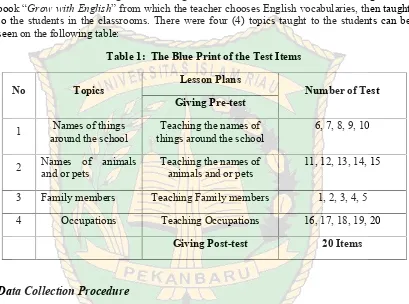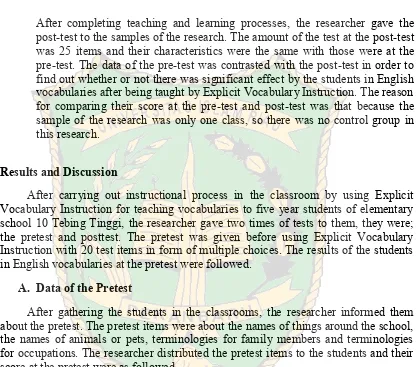THE EFFECT OF EXPLICIT VOCABULARY INSTRUCTION STRATEGY TOWARDS THE STUDENTS’ ENGLISH VOCABULARIES OF FIVE YEAR
STUDENTS OF ELEMENTARY SCHOOL 10 OF TEBING TINGGI MERANTI
* Nia Rosiana, **Syofianis,**Khulaifiyah ** Dosen FKIP Universitas Islam Riau * Mahasiswa FKIP Universitas Islam Riau
Abstract
The objective of this research was to find out the effect of explicit vocabulary instruction towards students’ vocabulary comprehension. Explicit Vocabulary Instruction emphasized on specific word meanings through word exposure. Explicit Vocabulary Instruction was used for the five year students of elementary school 10 Tebing Tinggi in academic year 2012-2013. The researcher used experimental design, which was specifically in form of one group pre-test post-test design. Independent variable was the use of Explicit Vocabulary Instruction strategy, while dependent variable was the students’ score in English vocabularies at the pre-test and post-test. The amount of sample was as many as the amount of population, there was 28 students. The instrument was the test with 20 items and the topics were; names of things around the school, animals and or pets, family members and occupations. The research findings were as followed: (1) there was a significant effect of Explicit Vocabulary Instruction strategy on students’ English vocabularies of year five students at elementary school 10 Tebing Tinggi. (2) Alternative hypothesis was accepted and null hypothesis was rejected because the statistical analysis proved that the score of t- test > t-table (120.20 > 2.000) or t-test was greater than the score of t – table; and (3) the students’ highest correct answers were for “Names of Animals/Pets” and their lowest correct answers for “Occupations” at the pretest. While their highest correct answers were for “Occupations” and their lowest correct answers were for “Names of Things around the School” at the posttest.
Keyword: Effect, Explicit Vocabulary Instruction, Vocabularies.
Introduction
having knowledge of English during elementary school level. Unfortunately, there were some phenomenon about the students’ academic results in English vocabularies. Their problems in English were that; the students were not motivated to learn English vocabularies because the teacher uses traditional teaching approach, they often joined remedial process because their scores were lower than minimum criterion achievement (KKM), the minimum score was 68 points, they often kept silent when being asked by the teacher about the English vocabularies, they often forgot the English vocabularies in hurry, and the English teacher still used traditional teaching approach during teaching English vocabularies to the students, it made the students were inactive during learning process because of teacher-centered instruction rather than student-centered instruction. Therefore, the researcher used Explicit Vocabulary Instruction in order to overcome the students’ problems in English vocabularies. It was a teaching strategy that was used particularly in teaching English vocabulary, especially for the students of elementary school. Explicit Vocabulary Instruction was a teaching strategy with five (5) steps. This teaching strategy emphasized upon “repeated exposure” to English vocabularies until they students understand them well. On the other words, the teacher exposed the word to the students again and again until they surely understood those words well, if they did not understand them, the teacher exposed them again. This strategy was used to strengthen the students’ memory about new words they learnt.
Methodology
This research methodology was an experimental research which wass specifically in form of one group pre-test post-test design. The researcher designed in form of one group pre-test post-test design because the students consisted of one class only at fifth grade students of 10 elementary school of Tebing Tinggi. Statistical analysis was used to know the students’ scores in English vocabularies at the pre-test and post-test. Furthermore, this research consisted of two variables; independent and dependent variables. Independent variable was the use of Explicit Vocabulary Instruction strategy, while dependent variable was the students’ score in English vocabularies at the pre-test and post-test.
Participants
Instruments
The instrument used in this research was test. The test consisted of two kinds, they were the pre-test and post-test. The pre-test was given before applying Explicit Vocabulary Instruction Strategy and the post-test was given after the use of this strategy to the students in the classroom. The teaching materials taught to the students were taken from the English text book “Grow with English” from which the teacher chooses English vocabularies, then taught to the students in the classrooms. There were four (4) topics taught to the students can be seen on the following table:
Table 1: The Blue Print of the Test Items
No Topics
Lesson Plans
Number of Test Giving Pre-test
1 Names of things around the school
Teaching the names of things around the school
6, 7, 8, 9, 10
2 Names of animals and or pets
Teaching the names of animals and or pets
11, 12, 13, 14, 15
3 Family members Teaching Family members 1, 2, 3, 4, 5
4 Occupations Teaching Occupations 16, 17, 18, 19, 20
Giving Post-test 20 Items
Data Collection Procedure
The technique used by the researcher to collect the data from the sample of the research was test in form of multiple choices. Data collection technique is as follows:
a. The Pre-test
Before using Explicit Vocabulary Instruction in teaching process, the researcher gave the pre-test to the sample of the research. The amount of test was 20 items, in which 1) things around the school consists of 5 items, 2) the names of animals and or pets consisted of 5 items, 3) the terminologies for family members consisted of 5 items, and 4) the terminologies for occupations consisted of 5 items. The pretest activity was carried out at Meeting 1.
b. Treatment
students’ English vocabularies. The teacher applied Explicit Vocabulary Instruction strategy.
c. The Post-test
After completing teaching and learning processes, the researcher gave the post-test to the samples of the research. The amount of the test at the post-test was 25 items and their characteristics were the same with those were at the pre-test. The data of the pre-test was contrasted with the post-test in order to find out whether or not there was significant effect by the students in English vocabularies after being taught by Explicit Vocabulary Instruction. The reason for comparing their score at the pre-test and post-test was that because the sample of the research was only one class, so there was no control group in this research.
Results and Discussion
After carrying out instructional process in the classroom by using Explicit Vocabulary Instruction for teaching vocabularies to five year students of elementary school 10 Tebing Tinggi, the researcher gave two times of tests to them, they were; the pretest and posttest. The pretest was given before using Explicit Vocabulary Instruction with 20 test items in form of multiple choices. The results of the students in English vocabularies at the pretest were followed.
A. Data of the Pretest
After gathering the students in the classrooms, the researcher informed them about the pretest. The pretest items were about the names of things around the school, the names of animals or pets, terminologies for family members and terminologies for occupations. The researcher distributed the pretest items to the students and their score at the pretest were as followed.
Table 2: Students’ Correct Answers for Each Kind of English Vocabularies at the Pretest
Kinds of Vocabularies
Names of Things around the
School
Names of Animal/Pet
Family
Members Occupations
Total Correct Answers
Total 98 102 101 97 398
Based on the data presented on Table 2, it was found that total correct answers by 28 students for “names of things around the school” were 98 points with average scores were 3.5 points. The total correct answers for “names of animals or pets” were 102 points with average scores were 3.64 points. While total correct answers for “family members” were 101 points with average scores were 3.60 points. Then total correct answers for “occupations” were 97 points with average scores were 3.46 points. Finally, total correct answers for four kinds of English vocabularies being tested to students were 398 points with average scores were 14.07 points.
Therefore, it could be concluded that the highest correct answers achieved by fifth year students of SDN 10 Tebing Tinggi was about “names of animals”, while the lowest correct answer was about “occupations”. The students felt easy to answer the test items for “names of animals” and they felt difficult to answer the test items for “occupation” at the pretest.
B. Data of the Posttest
After carrying out teaching process with Explicit Vocabulary Instruction for four times to teaching English vocabularies to five year students of elementary school 10 Tebing Tinggi, the researcher gave them the posttest with 20 items as similar as at the pretest. After giving them time for 35 minutes for completion, the researcher collected their answer sheets and analyzed them statistically to know their true answers for the posttest items. The results of their answers at the posttest were as followed.
Table 3:Students’ Correct Answers for Each Kind of English Vocabularies at the Posttest
correct answers for “occupations” were 112 points with average scores were 4 points. Finally, total correct answers for four kinds of English vocabularies being tested to students were 431 points with average scores were 15.39 points.
Conclusion
The researcher made the research conclusion based on the research findings after completing statistical analysis of the data of the pretest and posttest conducted to the samples of the research. The statistical analysis was carried out in order to find the answer for the research question in the formulation of the problem. The statistical analysis was also carried out to determine which hypothesis of the research was accepted and rejected. The research findings were as followed:
1. There was a significant effect of Vocabulary Instruction strategy on English vocabularies by year five students of elementary school 10 Tebing Tinggi. It was proved that the mean scores of samples at the posttest was higher than their mean score at the pretest. (76.96 points at the posttest contrasted with 71.07 points at the pretest).
2. Alternative hypothesis was accepted and null hypothesis was rejected because the statistical analysis proved that the score oft- test(tobserved) was greater than the score of t –table (t statistic). (the score of t- test was 120.20 > the score of t –table was 2.000).
3.The students’ highest correct answers were for “Names of Animals/Pets” and their lowest correct answers for “Occupations” at the pretest. While their highest correct answers were for “Occupations” and their lowest correct answers were for “Names of Things around the School” at the posttest.
References
Abdurrahman. 2008. Pengajaran Bahasa Inggris dengan Explicit Vocabulary Instruction, http//www.mind-map-teaching-english.com (Accessed on June, 2011).
Arikunto, Suharsimi. 2001. Prosedur Penelitian: Suatu Pendekatan Praktek, Jakarta: P.T. Gramedia Pustaka Jaya.
Bernard, John. 2008.The Theory of Explicit Vocabulary Instruction, USA: University of Colorado.
Brown, Dean James. 1988. Understanding Research in Second Language Learning, USA: Cambridge University Press.
Feldman, Kevin, et.al. 2008. Language Gap: The Case for Explicit Vocabulary Instruction, USA: Scholastic.
Hornby, As. 2001.Advanced English Dictionary, London: Oxford University Press. Johnson, Patrick. 2009. Providing Explicit Vocabulary Instruction,
Http.Blogspot.instruction.edu.com/ (Accessed on June, 2011).
Krey, Lindsay. 2009. Explicit Vocabulary Instruction: Focusing on at the Growing up and Getting Smart at Early Childhood, USA: Language and Literacy Catherine Snow and Barbara Pan.
Lehr, Fran, et.al. Focus on Vocabulary, Specific Research for Education and Learning. Http// Prel.org.com/ (Accessed on March, 2012).
Luchini, Pedro, et.al. 2009 Explicit Vocabulary Instruction: Exploring Second
Language Vocabulary Instruction, Http// Blogspor.
Vocabulary.instruction.com/ (Accessed on June, 2011).
Melchior, Deon. 2006. Boost Your Vocabulary and Become a Better Learner, Canada: Toronto Publishing Inc.
Nadarajan, Shanthi. 2009. The Effect of Instruction and Context on L2 Learners’ Vocabulary Development. http://e-flt.nus.edu.sg/v6n22009/nadarajan.htm (Accessed on June, 2011).
Nia Rahmawati, 2009: Teaching Vocabulary through Explicit Vocabulary Instruction
Technique to the Tenth Grade Students of SMAN 15
Palembang.Http.www.mindmap.teaching.vocabulary.com/(Accessed on June, 2011).
Novianti, 2008: Improving the Vocabulary Mastery of the Second Year Students of SMP Negeri 1 Parepare by Using Explicit Vocabulary Instruction. Http.www.novianti-mind-map-pembelajaran-com/(Accessed on June, 2011).
Pikulski, John. P, et.al. 2008. Explicit Vocabulary Instructionping: Teaching and Developing Vocabulary,USA: Houghton Mifflin Inc.


